Deck 9: Work
Question
Question
Question
Question
Question
Question
Question
Question
Question
Question
Question
Question
Question
Question
Question
Question
Question
Question
Question
Question
Question
Question
Question
Question
Question
Question
Question
Question
Question
Question
Question
Question
Question
Question
Question
Question
Question
Question
Question
Question
Question
Question
Question
Question
Question
Question
Question
Question

Unlock Deck
Sign up to unlock the cards in this deck!
Unlock Deck
Unlock Deck
1/48
Play
Full screen (f)
Deck 9: Work
1
A graph of the force on an object as a function of its position is shown in the figure. Determine the amount of work done by this force on an object that moves from x = 1.0 m to x = 6.0 m. (Assume an accuracy of 2 significant figures for the numbers on the graph.) 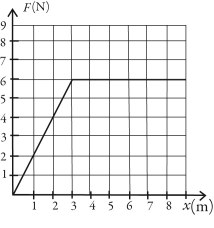
A) 26 J
B) 29 J
C) 22 J
D) 35 J
E) 27 J

A) 26 J
B) 29 J
C) 22 J
D) 35 J
E) 27 J
26 J
2
A box of mass m is pressed against (but is not attached to)an ideal spring of force constant k and negligible mass,compressing the spring a distance x.After it is released,the box slides up a frictionless incline as shown in the figure and eventually stops.If we repeat this experiment but instead use a spring having force constant 2k 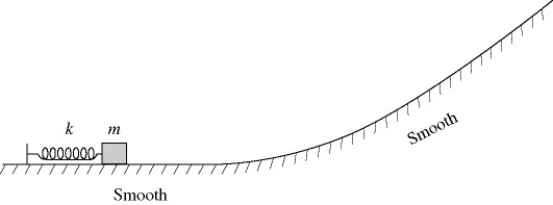
A) the box will go up the incline twice as high as before.
B) just as it moves free of the spring, the kinetic energy of the box will be twice as great as before.
C) just as it moves free of the spring, the speed of the box will be times as great as before.
times as great as before.
D) All of the above choices are correct.
E) None of the above choices is correct.

A) the box will go up the incline twice as high as before.
B) just as it moves free of the spring, the kinetic energy of the box will be twice as great as before.
C) just as it moves free of the spring, the speed of the box will be
 times as great as before.
times as great as before.D) All of the above choices are correct.
E) None of the above choices is correct.
All of the above choices are correct.
3
Two objects,one of mass m and the other of mass 2m,are dropped from the top of a building.When they hit the ground
A) both of them will have the same kinetic energy.
B) the heavier one will have twice the kinetic energy of the lighter one.
C) the heavier one will have four times the kinetic energy of the lighter one.
D) the heavier one will have times the kinetic energy of the lighter one.
times the kinetic energy of the lighter one.
A) both of them will have the same kinetic energy.
B) the heavier one will have twice the kinetic energy of the lighter one.
C) the heavier one will have four times the kinetic energy of the lighter one.
D) the heavier one will have
 times the kinetic energy of the lighter one.
times the kinetic energy of the lighter one.the heavier one will have twice the kinetic energy of the lighter one.
4
A 4.0-kg object is moving with speed 2.0 m/s.A 1.0-kg object is moving with speed 4.0 m/s.Both objects encounter the same constant braking force,and are brought to rest.Which object travels the greater distance before stopping?
A) the 4.0-kg object
B) the 1.0-kg object
C) Both objects travel the same distance.
D) It is impossible to know without knowing how long each force acts.
A) the 4.0-kg object
B) the 1.0-kg object
C) Both objects travel the same distance.
D) It is impossible to know without knowing how long each force acts.

Unlock Deck
Unlock for access to all 48 flashcards in this deck.
Unlock Deck
k this deck
5
Swimmers at a water park have a choice of two frictionless water slides as shown in the figure.Although both slides drop over the same height,h,slide 1 is straight while slide 2 is curved,dropping quickly at first and then leveling out.How does the speed v1 of a swimmer reaching the end of slide 1 compares with v2,the speed of a swimmer reaching the end of slide 2? 
A) v1 > v2
B) v1 < v2
C) v1 = v2
D) No simple relationship exists between v1 and v2 because we do not know the curvature of slide 2.

A) v1 > v2
B) v1 < v2
C) v1 = v2
D) No simple relationship exists between v1 and v2 because we do not know the curvature of slide 2.

Unlock Deck
Unlock for access to all 48 flashcards in this deck.
Unlock Deck
k this deck
6
A ball drops some distance and gains 30 J of kinetic energy.Do NOT ignore air resistance.How much gravitational potential energy did the ball lose?
A) more than 30 J
B) exactly 30 J
C) less than 30 J
A) more than 30 J
B) exactly 30 J
C) less than 30 J

Unlock Deck
Unlock for access to all 48 flashcards in this deck.
Unlock Deck
k this deck
7
A ball drops some distance and loses 30 J of gravitational potential energy.Do NOT ignore air resistance.How much kinetic energy did the ball gain?
A) more than 30 J
B) exactly 30 J
C) less than 30 J
A) more than 30 J
B) exactly 30 J
C) less than 30 J

Unlock Deck
Unlock for access to all 48 flashcards in this deck.
Unlock Deck
k this deck
8
When an object is solely under the influence of conservative forces,the sum of its kinetic and potential energies does not change.

Unlock Deck
Unlock for access to all 48 flashcards in this deck.
Unlock Deck
k this deck
9
A stock person at the local grocery store has a job consisting of the following five segments:
(1)picking up boxes of tomatoes from the stockroom floor
(2)accelerating to a comfortable speed
(3)carrying the boxes to the tomato display at constant speed
(4)decelerating to a stop
(5)lowering the boxes slowly to the floor.
During which of the five segments of the job does the stock person do positive work on the boxes?
A) (1) and (5)
B) (1) only
C) (1), (2), (4), and (5)
D) (1) and (2)
E) (2) and (3)
(1)picking up boxes of tomatoes from the stockroom floor
(2)accelerating to a comfortable speed
(3)carrying the boxes to the tomato display at constant speed
(4)decelerating to a stop
(5)lowering the boxes slowly to the floor.
During which of the five segments of the job does the stock person do positive work on the boxes?
A) (1) and (5)
B) (1) only
C) (1), (2), (4), and (5)
D) (1) and (2)
E) (2) and (3)

Unlock Deck
Unlock for access to all 48 flashcards in this deck.
Unlock Deck
k this deck
10
Two identical balls are thrown directly upward,ball A at speed v and ball B at speed 2v,and they feel no air resistance.Which statement about these balls is correct?
A) Ball B will go twice as high as ball A because it had twice the initial speed.
B) Ball B will go four times as high as ball A because it had four times the initial kinetic energy.
C) The balls will reach the same height because they have the same mass and the same acceleration.
D) At its highest point, ball B will have twice as much gravitational potential energy as ball A because it started out moving twice as fast.
E) At their highest point, the acceleration of each ball is instantaneously equal to zero because they stop for an instant.
A) Ball B will go twice as high as ball A because it had twice the initial speed.
B) Ball B will go four times as high as ball A because it had four times the initial kinetic energy.
C) The balls will reach the same height because they have the same mass and the same acceleration.
D) At its highest point, ball B will have twice as much gravitational potential energy as ball A because it started out moving twice as fast.
E) At their highest point, the acceleration of each ball is instantaneously equal to zero because they stop for an instant.

Unlock Deck
Unlock for access to all 48 flashcards in this deck.
Unlock Deck
k this deck
11
If a force always acts perpendicular to an object's direction of motion,that force cannot change the object's kinetic energy.

Unlock Deck
Unlock for access to all 48 flashcards in this deck.
Unlock Deck
k this deck
12
A box of mass m is pressed against (but is not attached to)an ideal spring of force constant k and negligible mass,compressing the spring a distance x.After it is released,the box slides up a frictionless incline as shown in the figure and eventually stops.If we repeat this experiment with a box of mass 2m 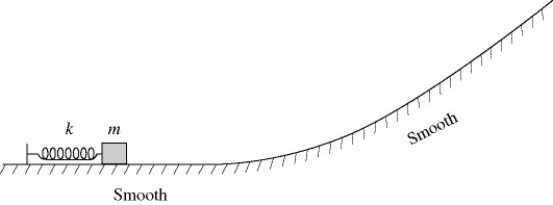
A) the lighter box will go twice as high up the incline as the heavier box.
B) just as it moves free of the spring, the lighter box will be moving twice as fast as the heavier box.
C) both boxes will have the same speed just as they move free of the spring.
D) both boxes will reach the same maximum height on the incline.
E) just as it moves free of the spring, the heavier box will have twice as much kinetic energy as the lighter box.

A) the lighter box will go twice as high up the incline as the heavier box.
B) just as it moves free of the spring, the lighter box will be moving twice as fast as the heavier box.
C) both boxes will have the same speed just as they move free of the spring.
D) both boxes will reach the same maximum height on the incline.
E) just as it moves free of the spring, the heavier box will have twice as much kinetic energy as the lighter box.

Unlock Deck
Unlock for access to all 48 flashcards in this deck.
Unlock Deck
k this deck
13
Two men,Joel and Jerry,push against a wall.Jerry stops after 10 min,while Joel is able to push for 5.0 min longer.Compare the work they do.
A) Both men do positive work, but Joel does 75% more work than Jerry.
B) Both men do positive work, but Joel does 50% more work than Jerry.
C) Both men do positive work, but Jerry does 50% more work than Joel.
D) Both men do positive work, but Joel does 25% more work than Jerry.
E) Neither of them does any work.
A) Both men do positive work, but Joel does 75% more work than Jerry.
B) Both men do positive work, but Joel does 50% more work than Jerry.
C) Both men do positive work, but Jerry does 50% more work than Joel.
D) Both men do positive work, but Joel does 25% more work than Jerry.
E) Neither of them does any work.

Unlock Deck
Unlock for access to all 48 flashcards in this deck.
Unlock Deck
k this deck
14
Which,if any,of the following statements concerning the work done by a conservative force is NOT true?
A) It can always be expressed as the difference between the initial and final values of a potential energy function.
B) It is independent of the path of the body and depends only on the starting and ending points.
C) When the starting and ending points are the same, the total work is zero.
D) All of the above statements are true.
E) None of the above statements are true.
A) It can always be expressed as the difference between the initial and final values of a potential energy function.
B) It is independent of the path of the body and depends only on the starting and ending points.
C) When the starting and ending points are the same, the total work is zero.
D) All of the above statements are true.
E) None of the above statements are true.

Unlock Deck
Unlock for access to all 48 flashcards in this deck.
Unlock Deck
k this deck
15
A box of mass m is pressed against (but is not attached to)an ideal spring of force constant k and negligible mass,compressing the spring a distance x.After it is released,the box slides up a frictionless incline as shown in the figure and eventually stops.If we repeat this experiment but instead compress the spring a distance of 2x 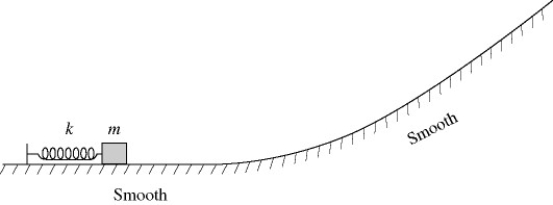
A) the box will go up the incline twice as high as before.
B) just as it moves free of the spring, the box will be traveling twice as fast as before.
C) just as it moves free of the spring, the box will be traveling four times as fast as before.
D) just as it moves free of the spring, the box will have twice as much kinetic energy as before.
E) just before it is released, the box has twice as much elastic potential energy as before.

A) the box will go up the incline twice as high as before.
B) just as it moves free of the spring, the box will be traveling twice as fast as before.
C) just as it moves free of the spring, the box will be traveling four times as fast as before.
D) just as it moves free of the spring, the box will have twice as much kinetic energy as before.
E) just before it is released, the box has twice as much elastic potential energy as before.

Unlock Deck
Unlock for access to all 48 flashcards in this deck.
Unlock Deck
k this deck
16
You carry a 7.0 kg bag of groceries 1.2 m above the level floor at a constant velocity of 75 cm/s across a room that is 2.3 m room.How much work do you do on the bag in the process?
A) 0.0 J
B) 82 J
C) 158 J
D) 134 J
A) 0.0 J
B) 82 J
C) 158 J
D) 134 J

Unlock Deck
Unlock for access to all 48 flashcards in this deck.
Unlock Deck
k this deck
17
Two stones,one of mass m and the other of mass 2m,are thrown directly upward with the same velocity at the same time from ground level and feel no air resistance.Which statement about these stones is true?
A) The heavier stone will go twice as high as the lighter one because it initially had twice as much kinetic energy.
B) Both stones will reach the same height because they initially had the same amount of kinetic energy.
C) At their highest point, both stones will have the same gravitational potential energy because they reach the same height.
D) At its highest point, the heavier stone will have twice as much gravitational potential energy as the lighter one because it is twice as heavy.
E) The lighter stone will reach its maximum height sooner than the heavier one.
A) The heavier stone will go twice as high as the lighter one because it initially had twice as much kinetic energy.
B) Both stones will reach the same height because they initially had the same amount of kinetic energy.
C) At their highest point, both stones will have the same gravitational potential energy because they reach the same height.
D) At its highest point, the heavier stone will have twice as much gravitational potential energy as the lighter one because it is twice as heavy.
E) The lighter stone will reach its maximum height sooner than the heavier one.

Unlock Deck
Unlock for access to all 48 flashcards in this deck.
Unlock Deck
k this deck
18
An object is acted upon by a force that represented by the force vs.position graph in the figure.What is the work done as the object moves
(a) from 4 m to 6 m?
(b) from 6 m to 12 m?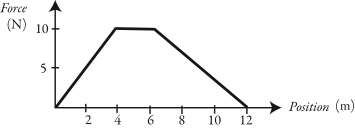
(a) from 4 m to 6 m?
(b) from 6 m to 12 m?


Unlock Deck
Unlock for access to all 48 flashcards in this deck.
Unlock Deck
k this deck
19
Three cars (car F,car G,and car H)are moving with the same velocity when the driver suddenly slams on the brakes,locking the wheels.The most massive car is car F,the least massive is car H,and all three cars have identical tires.
(a)Which car travels the longest distance to skid to a stop?
A)Car F
B)Car G
C)Car H
D)They all travel the same distance in stopping.
(b)For which car does friction do the largest amount of work in stopping the car?
A)Car F
B)Car G
C)Car H
D)The amount of work done by friction is the same for all cars.
(a)Which car travels the longest distance to skid to a stop?
A)Car F
B)Car G
C)Car H
D)They all travel the same distance in stopping.
(b)For which car does friction do the largest amount of work in stopping the car?
A)Car F
B)Car G
C)Car H
D)The amount of work done by friction is the same for all cars.

Unlock Deck
Unlock for access to all 48 flashcards in this deck.
Unlock Deck
k this deck
20
A crane lifts a 425 kg steel beam vertically a distance of 117 m.How much work does the crane do on the beam if the beam accelerates upward at 1.8 m/s2? Neglect frictional forces.
A) 5.8 × 105 J
B) 3.4 × 105 J
C) 4.0 × 105 J
D) 4.9 × 105 J
A) 5.8 × 105 J
B) 3.4 × 105 J
C) 4.0 × 105 J
D) 4.9 × 105 J

Unlock Deck
Unlock for access to all 48 flashcards in this deck.
Unlock Deck
k this deck
21
A constant horizontal pull acts on a sled on a horizontal frictionless ice pond.The sled starts from rest.When the pull acts over a distance x,the sled acquires a speed v and a kinetic energy K.If the same pull instead acts over twice this distance:
A) The sled's speed will be 2v and its kinetic energy will be 2K.
B) The sled's speed will be 2v and its kinetic energy will be K
C) The sled's speed will be v and its kinetic energy will be 2K.
and its kinetic energy will be 2K.
D) The sled's speed will be v and its kinetic energy will be K
and its kinetic energy will be K

E) The sled's speed will be 4v and its kinetic energy will be 2K.
A) The sled's speed will be 2v and its kinetic energy will be 2K.
B) The sled's speed will be 2v and its kinetic energy will be K

C) The sled's speed will be v
 and its kinetic energy will be 2K.
and its kinetic energy will be 2K.D) The sled's speed will be v
 and its kinetic energy will be K
and its kinetic energy will be K
E) The sled's speed will be 4v and its kinetic energy will be 2K.

Unlock Deck
Unlock for access to all 48 flashcards in this deck.
Unlock Deck
k this deck
22
An unusual spring has a restoring force of magnitude F = (2.00 N/m)x + (1.00 N/m2)x2,where x is the stretch of the spring from its equilibrium length.A 3.00-kg object is attached to this spring and released from rest after stretching the spring 1.50 m. If the object slides over a frictionless horizontal surface,how fast is it moving when the spring returns to its equilibrium length?
A) 2.06 m/s
B) 4.33 m/s
C) 3.27 m/s
D) 5.48 m/s
E) 1.50 m/s
A) 2.06 m/s
B) 4.33 m/s
C) 3.27 m/s
D) 5.48 m/s
E) 1.50 m/s

Unlock Deck
Unlock for access to all 48 flashcards in this deck.
Unlock Deck
k this deck
23
A force on a particle depends on position such that F(x)= (3.00 N/m2)x2 + (6.00 N/m)x for a particle constrained to move along the x-axis. What work is done by this force on a particle that moves from x = 0.00 m to x = 2.00 m?
A) 10.0 J
B) 20.0 J
C) -48.0 J
D) 24.0 J
E) 48.0 J
A) 10.0 J
B) 20.0 J
C) -48.0 J
D) 24.0 J
E) 48.0 J

Unlock Deck
Unlock for access to all 48 flashcards in this deck.
Unlock Deck
k this deck
24
A 4.00-kg mass is attached to a very light ideal spring hanging vertically and hangs at rest in the equilibrium position. The spring constant of the spring is 1.00 N/cm. The mass is pulled downward 2.00 cm and released. What is the speed of the mass when it is 1.00 cm above the point from which it was released?
A) 0.0443 m/s
B) 0.0744 m/s
C) 0.0201 m/s
D) 0.0866 m/s
E) The mass will not reach the height specified.
A) 0.0443 m/s
B) 0.0744 m/s
C) 0.0201 m/s
D) 0.0866 m/s
E) The mass will not reach the height specified.

Unlock Deck
Unlock for access to all 48 flashcards in this deck.
Unlock Deck
k this deck
25
It requires 49 J of work to stretch an ideal very light spring from a length of 1.4 m to a length of 2.9 m.What is the value of the spring constant of this spring?
A) 15 N/m
B) 44 N/m
C) 29 N/m
D) 22 N/m
A) 15 N/m
B) 44 N/m
C) 29 N/m
D) 22 N/m

Unlock Deck
Unlock for access to all 48 flashcards in this deck.
Unlock Deck
k this deck
26
The force on a 3.00-kg object as a function of position is shown in the figure. If an object is moving at 2.50 m/s when it is located at x = 2.00 m,what will its speed be when it reaches x = 8.00 m? (Assume that the numbers on the graph are accurate to 3 significant figures.) 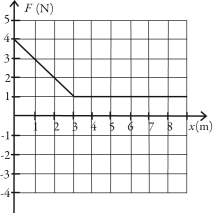
A) 3.25 m/s
B) 3.70 m/s
C) 4.10 m/s
D) 2.90 m/s
E) 4.50 m/s

A) 3.25 m/s
B) 3.70 m/s
C) 4.10 m/s
D) 2.90 m/s
E) 4.50 m/s

Unlock Deck
Unlock for access to all 48 flashcards in this deck.
Unlock Deck
k this deck
27
A car needs to generate 75.0 hp in order to maintain a constant velocity of 27.3 m/s on a flat road.What is the magnitude of the total resistive force acting on the car (due to friction,air resistance,etc.)?
(1 hp = 746 W)
A) 2.05 × 103 N
B) 2.75 N
C) 1.03 × 103 N
D) 2.87 × 103 N
(1 hp = 746 W)
A) 2.05 × 103 N
B) 2.75 N
C) 1.03 × 103 N
D) 2.87 × 103 N

Unlock Deck
Unlock for access to all 48 flashcards in this deck.
Unlock Deck
k this deck
28
The work performed as a function of time for a process is given by W = at3,where a = 2.4 J/s3. What is the instantaneous power output at t = 3.7 s?
A) 99 W
B) 69 W
C) 139 W
D) 208 W
A) 99 W
B) 69 W
C) 139 W
D) 208 W

Unlock Deck
Unlock for access to all 48 flashcards in this deck.
Unlock Deck
k this deck
29
If electricity costs 6.00¢/kWh (kilowatt-hour),how much would it cost you to run a 120 W stereo system 4.0 hours per day for 4.0 weeks?
A) $0.81
B) $0.12
C) $1.38
D) $2.27
A) $0.81
B) $0.12
C) $1.38
D) $2.27

Unlock Deck
Unlock for access to all 48 flashcards in this deck.
Unlock Deck
k this deck
30
In the figure,two identical springs have unstretched lengths of 0.25 m and spring constants of 300 N/m.The springs are attached to a small cube and stretched to a length L of 0.36 m as in Figure A.An external force P pulls the cube a distance D = 0.020 m to the right and holds it there.(See Figure B.)The work done by the external force P in pulling the cube 0.020 m is closest to 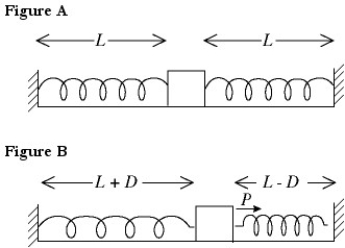
A) 0.12 J.
B) 0.060 J.
C) 6.0 J.
D) 12 J.
E) 0.80 J.

A) 0.12 J.
B) 0.060 J.
C) 6.0 J.
D) 12 J.
E) 0.80 J.

Unlock Deck
Unlock for access to all 48 flashcards in this deck.
Unlock Deck
k this deck
31
A force F = bx3 acts in the x direction,where the value of b is 3.7 N/m3. How much work is done by this force in moving an object from x = 0.00 m to x = 2.6 m?
A) 42 J
B) 13 J
C) 50 J
D) 57 J
A) 42 J
B) 13 J
C) 50 J
D) 57 J

Unlock Deck
Unlock for access to all 48 flashcards in this deck.
Unlock Deck
k this deck
32
A 1000 kg car experiences a net force of 9500 N while decelerating from 30.0 m/s to 23.4 m/s.How far does it travel while slowing down?
A) 18.5 m
B) 17.4 m
C) 20.2 m
D) 21.9 m
A) 18.5 m
B) 17.4 m
C) 20.2 m
D) 21.9 m

Unlock Deck
Unlock for access to all 48 flashcards in this deck.
Unlock Deck
k this deck
33
A worker lifts a 20.0-kg bucket of concrete from the ground up to the top of a 20.0-m tall building.The bucket is initially at rest,but is traveling at 4.0 m/s when it reaches the top of the building. What is the minimum amount of work that the worker did in lifting the bucket?
A) 3.92 kJ
B) 400 J
C) 560 J
D) 4.08 kJ
E) 160 J
A) 3.92 kJ
B) 400 J
C) 560 J
D) 4.08 kJ
E) 160 J

Unlock Deck
Unlock for access to all 48 flashcards in this deck.
Unlock Deck
k this deck
34
A person pushes horizontally on a heavy box and slides it across the level floor at constant velocity.The person pushes with a 60.0 N force for the first 6.88 m,at which time he begins to tire.The force he exerts then starts to decrease linearly from 60.0 N to 0.00 N across the remaining 6.88 m.How much total work did the person do on the box?
A) 619 J
B) 826 J
C) 495 J
D) 925 J
A) 619 J
B) 826 J
C) 495 J
D) 925 J

Unlock Deck
Unlock for access to all 48 flashcards in this deck.
Unlock Deck
k this deck
35
A 1500-kg car accelerates from 0 to 25 m/s in 7.0 s with negligible friction and air resistance. What is the average power delivered by the engine? (1 hp = 746 W)
A) 50 hp
B) 60 hp
C) 70 hp
D) 80 hp
E) 90 hp
A) 50 hp
B) 60 hp
C) 70 hp
D) 80 hp
E) 90 hp

Unlock Deck
Unlock for access to all 48 flashcards in this deck.
Unlock Deck
k this deck
36
You slam on the brakes of your car in a panic,and skid a certain distance on a straight,level road. If you had been traveling twice as fast,what distance would the car have skidded,under identical conditions?
A) It would have skidded 4 times farther.
B) It would have skidded 2 times farther.
C) It would have skidded times farther.
times farther.
D) It would have skidded 1/ times farther.
times farther.
E) It would have skidded 1/2 as far.
A) It would have skidded 4 times farther.
B) It would have skidded 2 times farther.
C) It would have skidded
 times farther.
times farther.D) It would have skidded 1/
 times farther.
times farther.E) It would have skidded 1/2 as far.

Unlock Deck
Unlock for access to all 48 flashcards in this deck.
Unlock Deck
k this deck
37
A graph of the force on an object as a function of its position is shown in the figure. Determine the amount of work done by this force on the object during a displacement from x = -2.00 m to x = 2.00 m.(Assume an accuracy of 3 significant figures for the numbers on the graph.) 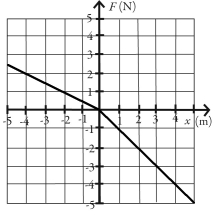
A) -12.0 J
B) -3.00 J
C) -1.00 J
D) 12.0 J
E) 3.00 J

A) -12.0 J
B) -3.00 J
C) -1.00 J
D) 12.0 J
E) 3.00 J

Unlock Deck
Unlock for access to all 48 flashcards in this deck.
Unlock Deck
k this deck
38
A 7.0-kg rock is subject to a variable force given by the equation
F(x)= 6.0 N - (2.0 N/m)x + (6.0 N/m2)x2
If the rock initially is at rest at the origin,find its speed when it has moved 9.0 m.
F(x)= 6.0 N - (2.0 N/m)x + (6.0 N/m2)x2
If the rock initially is at rest at the origin,find its speed when it has moved 9.0 m.

Unlock Deck
Unlock for access to all 48 flashcards in this deck.
Unlock Deck
k this deck
39
A child pulls on a wagon with a horizontal force of 75 N. If the wagon moves horizontally a total of 42 m in 3.0 min,what is the average power generated by the child?
A) 18 W
B) 22 W
C) 24 W
D) 27 W
A) 18 W
B) 22 W
C) 24 W
D) 27 W

Unlock Deck
Unlock for access to all 48 flashcards in this deck.
Unlock Deck
k this deck
40
How long will it take a 7.08 hp motor to lift a 250 kg beam directly upward at constant velocity from the ground to a height of 45.0 m? Assume frictional forces are negligible.(1 hp = 746 W)
A) 20.9 s
B) 1.56 × 104 s
C) 2.18 × 104 s
D) 39.7 s
A) 20.9 s
B) 1.56 × 104 s
C) 2.18 × 104 s
D) 39.7 s

Unlock Deck
Unlock for access to all 48 flashcards in this deck.
Unlock Deck
k this deck
41
A mass is pressed against (but is not attached to)an ideal horizontal spring on a frictionless horizontal surface.After being released from rest,the mass acquires a maximum speed v and a maximum kinetic energy K.If instead the mass initially compresses the spring twice as far:
A) Its maximum speed will be 2v and its maximum kinetic energy will be 2K.
B) Its maximum speed will be 2v and its maximum kinetic energy will be K.
K.
C) Its maximum speed will be v and its maximum kinetic energy will be 2K.
and its maximum kinetic energy will be 2K.
D) Its maximum speed will be 2v and its maximum kinetic energy will be 4K.
E) Its maximum speed will be 4v and its maximum kinetic energy will be 2K.
A) Its maximum speed will be 2v and its maximum kinetic energy will be 2K.
B) Its maximum speed will be 2v and its maximum kinetic energy will be
 K.
K.C) Its maximum speed will be v
 and its maximum kinetic energy will be 2K.
and its maximum kinetic energy will be 2K.D) Its maximum speed will be 2v and its maximum kinetic energy will be 4K.
E) Its maximum speed will be 4v and its maximum kinetic energy will be 2K.

Unlock Deck
Unlock for access to all 48 flashcards in this deck.
Unlock Deck
k this deck
42
In the figure,a 5.00-kg block is moving at 5.00 m/s along a horizontal frictionless surface toward an ideal massless spring that is attached to a wall.After the block collides with the spring,the spring is compressed a maximum distance of 0.68 m.What is the speed of the block when it has moved so that the spring is compressed to only one-half of the maximum distance? 


Unlock Deck
Unlock for access to all 48 flashcards in this deck.
Unlock Deck
k this deck
43
A tennis ball bounces on the floor three times.If each time it loses 22.0% of its energy due to heating,how high does it rise after the third bounce,provided we released it 2.3 m from the floor?
A) 110 cm
B) 11 cm
C) 110 mm
D) 140 cm
A) 110 cm
B) 11 cm
C) 110 mm
D) 140 cm

Unlock Deck
Unlock for access to all 48 flashcards in this deck.
Unlock Deck
k this deck
44
An object is attached to a hanging unstretched ideal and massless spring and slowly lowered to its equilibrium position,a distance of 6.4 cm below the starting point.If instead of having been lowered slowly the object was dropped from rest,how far then would it then stretch the spring at maximum elongation?
A) 13 cm
B) 9.1 cm
C) 6.4 cm
D) 18 cm
E) 26 cm
A) 13 cm
B) 9.1 cm
C) 6.4 cm
D) 18 cm
E) 26 cm

Unlock Deck
Unlock for access to all 48 flashcards in this deck.
Unlock Deck
k this deck
45
An athlete stretches a spring an extra 40.0 cm beyond its initial length.How much energy has he transferred to the spring,if the spring constant is 52.9 N/cm?
A) 423 J
B) 4230 kJ
C) 423 kJ
D) 4230 J
A) 423 J
B) 4230 kJ
C) 423 kJ
D) 4230 J

Unlock Deck
Unlock for access to all 48 flashcards in this deck.
Unlock Deck
k this deck
46
A 60.0-kg person drops from rest a distance of 1.20 m to a platform of negligible mass supported by an ideal stiff spring of negligible mass.The platform drops 6.00 cm before the person comes to rest.What is the spring constant of the spring?
A) 2.56 × 105 N/m
B) 3.92 × 105 N/m
C) 5.45 × 104 N/m
D) 4.12 × 105 N/m
E) 8.83 × 104 N/m
A) 2.56 × 105 N/m
B) 3.92 × 105 N/m
C) 5.45 × 104 N/m
D) 4.12 × 105 N/m
E) 8.83 × 104 N/m

Unlock Deck
Unlock for access to all 48 flashcards in this deck.
Unlock Deck
k this deck
47
A spring-loaded dart gun is used to shoot a dart straight up into the air,and the dart reaches a maximum height of 24 meters above its point of release.The same dart is shot up a second time from the same gun,but this time the spring is compressed only half as far (compared to the first shot).How far up does the dart go this time? (Neglect friction and assume the spring is ideal and massless.)
A) 6.0 m
B) 12 m
C) 3.0 m
D) 48 m
A) 6.0 m
B) 12 m
C) 3.0 m
D) 48 m

Unlock Deck
Unlock for access to all 48 flashcards in this deck.
Unlock Deck
k this deck
48
An 8.0-g bullet is shot into a 4.0-kg block,at rest on a frictionless horizontal surface (see the figure).The bullet remains lodged in the block.The block moves into an ideal massless spring and compresses it by 8.7 cm.The spring constant of the spring is 2400 N/m.The initial velocity of the bullet is closest to 
A) 1100 m/s.
B) 1200 m/s.
C) 900 m/s.
D) 1300 m/s.
E) 1000 m/s.

A) 1100 m/s.
B) 1200 m/s.
C) 900 m/s.
D) 1300 m/s.
E) 1000 m/s.

Unlock Deck
Unlock for access to all 48 flashcards in this deck.
Unlock Deck
k this deck



